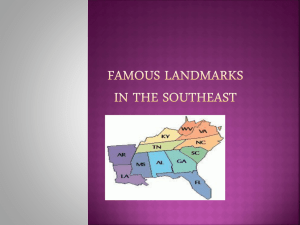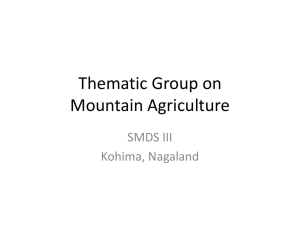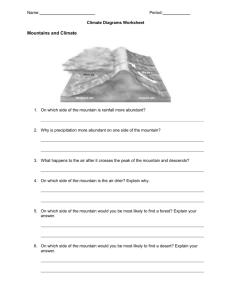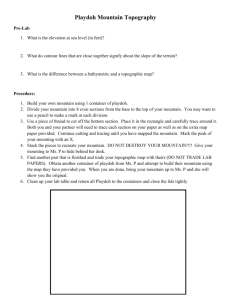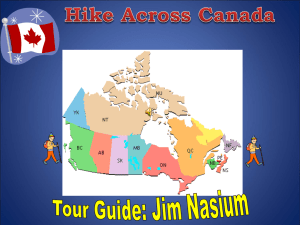see TMPA submission - Tamborine Mountain Progress Association
advertisement
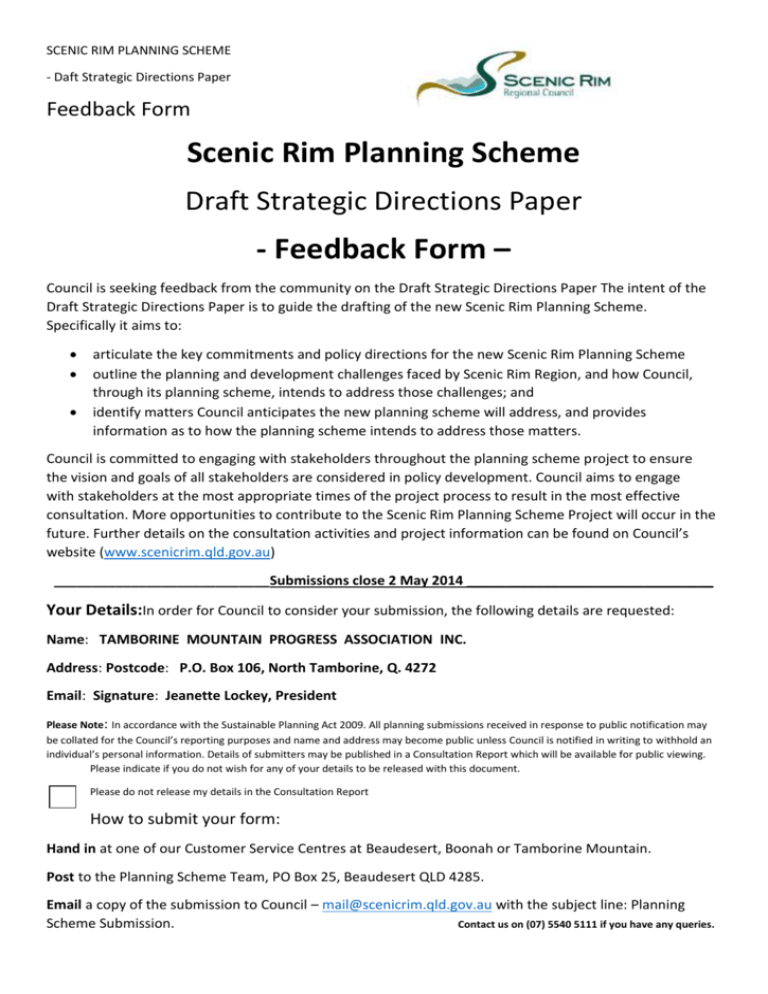
SCENIC RIM PLANNING SCHEME - Daft Strategic Directions Paper Feedback Form Scenic Rim Planning Scheme Draft Strategic Directions Paper - Feedback Form – Council is seeking feedback from the community on the Draft Strategic Directions Paper The intent of the Draft Strategic Directions Paper is to guide the drafting of the new Scenic Rim Planning Scheme. Specifically it aims to: articulate the key commitments and policy directions for the new Scenic Rim Planning Scheme outline the planning and development challenges faced by Scenic Rim Region, and how Council, through its planning scheme, intends to address those challenges; and identify matters Council anticipates the new planning scheme will address, and provides information as to how the planning scheme intends to address those matters. Council is committed to engaging with stakeholders throughout the planning scheme project to ensure the vision and goals of all stakeholders are considered in policy development. Council aims to engage with stakeholders at the most appropriate times of the project process to result in the most effective consultation. More opportunities to contribute to the Scenic Rim Planning Scheme Project will occur in the future. Further details on the consultation activities and project information can be found on Council’s website (www.scenicrim.qld.gov.au) ____________________________Submissions close 2 May 2014 ________________________________ Your Details:In order for Council to consider your submission, the following details are requested: Name: TAMBORINE MOUNTAIN PROGRESS ASSOCIATION INC. Address: Postcode: P.O. Box 106, North Tamborine, Q. 4272 Email: Signature: Jeanette Lockey, President Please Note: In accordance with the Sustainable Planning Act 2009. All planning submissions received in response to public notification may be collated for the Council’s reporting purposes and name and address may become public unless Council is notified in writing to withhold an individual’s personal information. Details of submitters may be published in a Consultation Report which will be available for public viewing. Please indicate if you do not wish for any of your details to be released with this document. Please do not release my details in the Consultation Report How to submit your form: Hand in at one of our Customer Service Centres at Beaudesert, Boonah or Tamborine Mountain. Post to the Planning Scheme Team, PO Box 25, Beaudesert QLD 4285. Email a copy of the submission to Council – mail@scenicrim.qld.gov.au with the subject line: Planning Scheme Submission. Contact us on (07) 5540 5111 if you have any queries. SCENIC RIM PLANNING SCHEME - Daft Strategic Directions Paper Feedback Form Please tick (X) which theme(s) your feedback relates to: X Scenery and Environment Nature conservation and biodiversity Environmental quality Natural hazards __________________________________________Landscape values____________________________ X Growing Economy Activity centre network Diversity, value adding, innovation & supply chains Industrial activities X __________________________________________Tourism activities_____________________________ Communities and Character Population growth and residential development Urban and rural character and design X __________________________________________Social infrastructure and services________________ Protected Natural Resources Natural resource management Soils and agricultural resources Extractive resources Natural tourism assets __________________________________________Water Resources______________________________ Sustainable Infrastructure Land use and infrastructure Key infrastructure and corridors __________________________________________Infrastructure standards_________________________ Your comments: Tamborine Mountain Progress Association is a century old community organisation. It is a registered Community Purpose organisation. As a relatively isolated community for many decades, volunteers, through the organisation, helped shape the mountain’s distinctive character. Its tourist attraction has been documented back to the 1890’s. Its farming history laid the foundations of today’s semi-rural character. X………SCENERY & ENVIRONMENT Tamborine Mountain’s biodiversity is well documented in the Watson Report. It has approximately 80% of the SEQ region’s flora and fauna. Preservation of the biodiversity in this State asset has to be carefully incorporated in the Shire Planning Scheme. The Escarpment Conservation areas should be retained. Wildlife corridors and special night lighting for night creatures also have a place in the Planning Scheme. The extensive commercial water extraction across the plateau does not take into consideration the lowering of the mountain’s subterranean water table and the potential adverse effect on the rainforests and local natural environment. This needs to be addressed in the planning scheme. Natural hazards……..One of the worst slip areas in the country is the eastern escarpment of Tamborine Mountain. Land slides there occur almost annually. The Planning Scheme should make this very clear as poorly informed approvals for subdivisions here in the past have led to disasters like that on Shelf Road. The splendid landscape values of Tamborine Mountain are well known globally. An easily accessed tourist destination in the Brisbane/Gold Coast areas, it is the views that most visitors take away with them. These key components of the mountain’s character have not been acknowledged by either the previous Beaudesert Shire Council or the present SRRC. Earlier suggestions by the TM Progress Association for a viewing point to the east had not been taken up. The views to the west are also spectacular. Two State Government studies recommended that views to the west, which are rare in SEQ, should be preserved. Currently there are two viewing sites to the west. One is the Rotary Lookout, and further south is the longer open stretch commonly known as the hang gliding site. The latter strip was extended by purchase of private land in 1996 by Beaudesert Shire Council, State Govt. and the Canungra Hang Gliding Club. The sweeping view from this site is the mountain’s prime scenic attraction for the thousands of vehicles passing this site daily. Currently this impact is being hi-jacked by a large sculptured rock, the product of an enterprise of a group in Beaudesert. Over a thousand residents and visitors recommended its relocation to a more suitable site. The landscape values of Tamborine Mountain also play an important role in the lifestyles of its residents. No resident is far from the stunning impacts of views to the east, west, north or south. Together with the overall semirural character across the plateau this imparts an open space, “country” character valued by its residents. It is why an estimated over 90% of the population has turned its back on suburbia and the infrastructure offered there. The Landscape Assessment of Tamborine Mountain was compiled by the State Government in 1995. Amongst other aspects, it also points to preservation of the vegetated mountain entry points such as the rain forested upper reaches of Tamborine Mountain Road as making significant statements ahead of a predominantly environmental experience. 2. X……..GROWING ECONOMY This has little relevance to the mountain. A small plateau cannot hope to provide the urban infrastructure so comprehensibly available in city and town centres close by. Most mountain residents choose to live in a non-urban, non-commercial/industrial area. The tourism activities are centred on Gallery Walk and numerous B & B’s and eateries across the mountain. Care should be taken to separate business activity from residential areas. Tourism is strongly based on the overall scenic attraction of the mountain and its distinction from other competing areas. A study by the TM Progress Association over a weekend a few years ago found 92%o of visitors chose the area over other options because of its natural environment. Fifteen percent were from overseas. A study by Tourism Queensland found Tamborine Mountain was the most visited day destination in SEQ. With an estimated 1.3 million visitors each year, the mountain presents as a quick easy “Clayton’s” trip into the country for the masses living or holidaying nearby. The mountain is not a major money earner, as many poorly researched businesses find to their cost. In 2013, a local group did a survey in Gallery Walk, and found that the average a person spent there was $6.40. As a green, attractive, semi-rural plateau, the mountain remains a key component in the State’s regional tourist drawcard. This is not by earning a few dollars and cents for a relatively few individuals, but by providing an area facet demanded by travellers from around the world. With tourism to play a more significant role as other resources decline, this regional asset should have strong protection in the Planning Scheme. See Beaudesert Shire Council minutes, Urban Footprint, Feb. 2006 3. X………COMMUNITIES AND CHARACTER The Tamborine Mountain community has evolved as a relatively isolated area for most of the past century. Mountain people looked after their own affairs, and indeed Tamborine Mountain was a separate shire till 1948. Population growth…Although the population grew rapidly from the 1990’s on, the successive waves of residents arrived because they liked what they encountered (often as tourists), and in their turn reinforced the environment/semi-rural character which distinguishes the area. Indeed, for an overall large population nearing 7,000, it is quite unique in the country. Feedback from the community over many years has indicated that having a population cap (via its Local Plan) is highly desirable. Preserving the local character and lack of infrastructure underpin this view. Social Infrastructure & Services………..What has not been understood by successive Councils is the peculiar ethos of mountain residents. Three thousand residents stated they did not want amalgamation with the Gold Coast and its urban – glitzy lifestyle. Their interaction with the environment in all the various precincts, plus the mountain’s strong community spirit is what residents value. For many reasons, a large number of residents like to have a day off the mountain. Everything (entertainment, eateries, shopping, medical etc.) is readily available on the Gold Coast. People have their favourite shopping malls and besides the Gold Coast, there is also Oxenford, Beaudesert (for a run somewhere different) and Beenleigh. The mountain’s population comprises mainly older residents and younger families – not a lot in between. Many residents feel swamped by the hordes of tourists that visit, and many do not venture out on the weekends. A highly valued characteristic of mountain life is the exceptionally high community spirit. This was reinforced in the Development Control Plan (1997) and its successor in 2007 by concentrating community activity in the mountain’s Central Business District. This is centered on the Main Street offshoot from the tourist route. It used to be a vibrant hub and meeting place for the community. Apparently unaware of the local ethos and way of life, a large supermarket was suggested and encouraged by Council (planning dept) outside the CBD although about 50% of Main Street is still available for commercial development. A number of older persons’ establishments were specially situated close to Main Street and about 400 residents had located nearby for easy access to the shops. Over 1,100 residents objected to the development. Some residents have described the fracturing of the CBD as a “tragedy” and it is fairly well known that the large supermarket is now experiencing “difficulties”. 4. Character………Tamborine Mountain is NOT URBAN. It is its non-urban character that attracts residents and visitors alike. There is even recorded historic evidence back to the 1890’s that people come to Tamborine Mountain to “escape urbanization”. This non-urban character is achieved by the separation of the village centres and residential estates by rural land and was advised and supported by earlier planners (some local residents). Also planning advice received was that as a relatively small plateau, it benefits from an overall view, otherwise a patchwork quilt pattern of development would extinguish the whole environment/semi-rural character. This enlightened view was lost when Council considered Development Applications for Hyacinth, St. Bernards and the large supermarket – all straddling key trafficked nodes of the mountain landscape. When the SEQ Regional Plan was being assembled, the newly appointed director of the Office of Urban Management (Lindsay Enright) visited Tamborine Mountain as part of an endeavour to ascertain just what makes communities different... A submission for placement of the Urban Footprint was subsequently assembled by representatives of about eight mountain organizations. It recommended the U F on the two village areas of Eagle Heights and North Tamborine. A much smaller U F was recommended for the south, around the convenience store there. This was in accordance with the aims of the Planning Scheme. Beaudesert Shire Council put in an almost identical submission. When the Urban Footprint came out (2005), the urban parts were much larger than appropriate for Tamborine Mountain. Apart from contradicting the intent of the Planning Scheme, it would seem the co-opted planner did not factor in the relevance of the mountain’s character to the important State tourism endeavours. With the great large demands on planning for e.g. the western corridor of Brisbane, etc. and the limited time frame, the resultant unsatisfactory Tamborine Mountain Urban Footprint was described by the Council’s senior planner as “Tamborine Mountain was just a blip on the horizon”. See Beaudesert Shire Council minutes attached. Earlier inappropriate planning decisions should not be consolidated in the shire’s Planning Scheme. 5. X………PROTECTED NATURAL RESOURCES Tamborine Mountain’s water problems have received wide attention through the recent two court cases, mainly the Gillion Pty. Ltd. case in both the District Court and the Supreme Court. Both businesses sought to expand to large industrial sized activites in residential streets. The Gillion appeals were dismissed in both Courts mainly on planning grounds. The mountain is not serviced by reticulated water. Residents rely on tank water, sometimes supplemented by bore water. There are about 1,000 bores on the mountain, not all currently in use. Several earlier small local water suppliers were in time bought out by much larger interests. Currently there are about eight major water extractors operating, with only about two supplying locals. Forums and feedback over the years have shown that water has been one of three issues which have been of most concern to residents. The other two are environment and population cap. New bores regularly diminish the levels in neighbouring bores. In the Gillion case, neighbouring bores failed and the adjoining nursery lost supply to its expensive new bore. This nursery is a lawful business and it was established in Court that it and Gillion both sourced the same aquifer. Two commercial water extractors have ceased or are about to cease operation. However, a number of other businesses still operate. Some, but not all, have a variety of approvals and conditions. Further approvals for commercial water extraction on Tamborine Mt. should not be approved. Commercial ground water extraction should be designated an Extractive Industries use under the planning scheme. Whilst ideally remaining an inconsistent use in the planning scheme, some recognition of small scale extraction for local use should be addressed. A licence approving water extraction should attach to the applicant and not the relevant land. Any conditions for water extraction operation and cartage by the 28,000 litre tankers should align with the conditions set by the court in the Gillion Pty. Ltd. v. SRRC & Ors, 2013. Compensation for damage to roads by loaded tankers should be considered. 6. ADDITIONAL COMMENTS The comments above illustrate some unusual planning considerations if the shire and the region itself are to retain the distinctive valuable character of Tamborine Mountain. Identifying the elements which give the area this character would go a long way to averting the consequences of less than satisfactory decisions made by poorly informed planners. With respect, Court comments such as Council made “major errors” and that its decisions were “inexplicable” and “incomprehensible” are the unfortunate results of a Council being out of step with community aspirations. And one does not want Council to be labelled by any outside expert as “irresponsible”. To alert distant council officers from applying many values which are applicable to other areas but not to Tamborine Mountain, there ideally should be a separate Tamborine Mountain Zone. Jeanette Lockey, President, Tamborine Mountain Progress Association 1st May, 2014 Return your comments by close of business 2 May 2014

